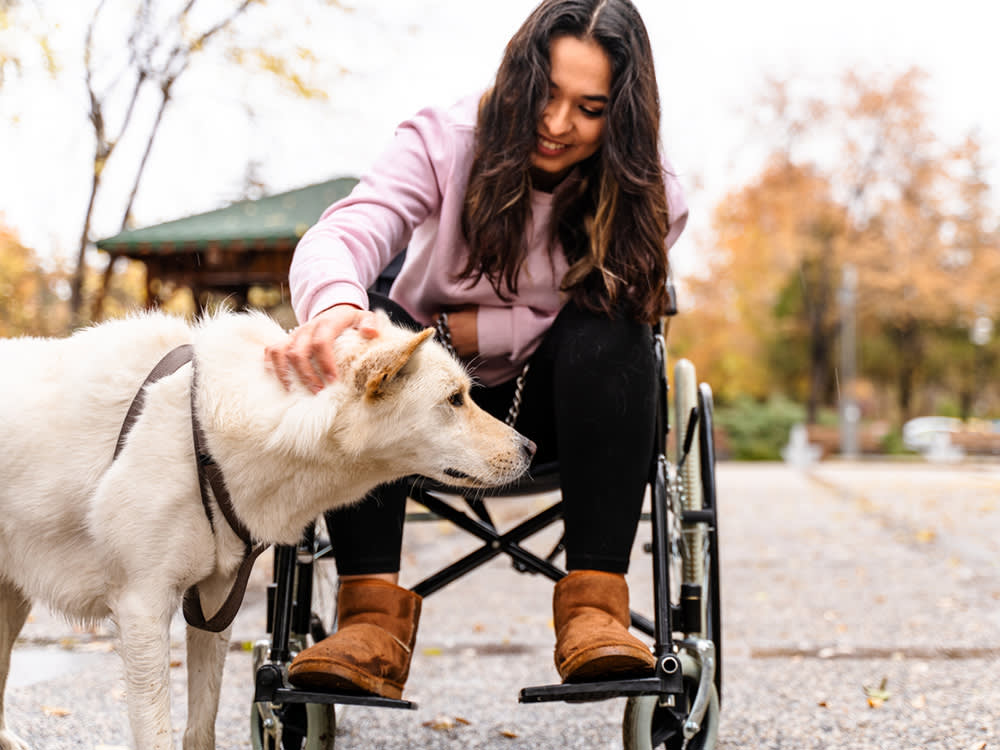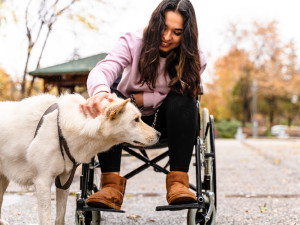Can I Register My Dog as a Service Dog?

Share Article
In This Article:
What are Service Dogs? Service Dog Requirements How to Register Your Dog as a Service Dog? Service Dog Registration Scams Service Dog Laws to Be Aware Of
If you are thinking about getting a service dog, or wondering how to get your dog registered as a service dog, you might not know where to begin. Read on to learn all about service dogs and service dog requirements, and find out how to make a dog a service dog.
What are service dogs?
Service dogs are dogs that are specially trained to perform specific tasks to assist a person with a disability. Although most people are familiar with transitional service dog breeds like Labrador Retrievers, Golden Retrievers, and German Shepherd Dogs, service dogs can be any breed or mix of any size. Although the list of what services dogs can do is almost endless, some common examples of tasks service dogs might perform include:
Alert a person to an impending seizure or blood sugar drop
Guide a blind person to navigate public spaces safely
Identify if food contains a life-threatening allergen
Stabilize a person who has trouble with balance
Alert a deaf person to fire alarms, doorbells, and other sounds
Retrieve items, turn on and off lights, or open and close doors for someone in a wheelchair
Redirect and calm someone with anxiety or PTSD
Alert to a autistic child eloping (running off)
Remind a person to take medication
Types of service dogs
There are many different types of service dogs. Some are trained to perform very unique tasks for disabled individuals. Some of the types of service dogs you might see include:
How much do you spend on your pet per year?

Guide dogs (Seeing Eye Dogs)
Hearing assistance dogs
Mobility assistance dogs
Medical alert dogs (for diabetes, seizures, and more)
Psychiatric service dogs (to assist with PTSD, anxiety, and other disorders)
Autism assistance dogs
ESA vs service dog
Many people think emotional support animals (ESA) are the same as service dogs, but the two are very different. Where service dogs are trained to perform specific tasks to help their handler manage a disability, emotional support animals require no specific training. Just their presence alone provides comfort and support to someone who might suffer from various mental or emotional conditions, such as anxiety, phobias, depression, PTSD, bipolar disorder, and other conditions.
Any pet, whether dog, cat, rabbit, or bird, can be an emotional support animal, but according to the law, only dogs can be service animals (and rarely, miniature horses). Legally, emotional support animals do not have the same public access rights as service dogs (though they are included in the Fair Housing Act, or FHA).
Service dog requirements
Service dog requirements are fairly simple. In order to be recognized as a service dog, a dog must meet the following criteria:
The dog must be trained to perform at least one specific task that directly helps with their handler’s disability. Many service dogs perform multiple tasks.
The dog must be well trained in general, and well behaved in public. They need to be comfortable with crowds and loud sounds, and completely focused on their handler.
They cannot be aggressive
Service dogs should be healthy and well groomed.
How to register your dog as a service dog
Contrary to popular belief, service dogs are not required to be registered. In the United States, there is no registry or official organization that recognizes service dogs. A dog qualifies as a service dog if their handler has a disability that limits their activities, and if the dog is trained to perform tasks that mitigate that disability. Service dogs should also be nonaggressive and well-behaved in public.
Service dogs must receive extensive training, not only to perform tasks that help with their handler’s disability, but also to be calm and well-behaved in public, as well as focused on their handler and their job. Service dogs can be trained by anyone, including their own handler. Some service dogs are raised and trained by organizations that specialize in this. Other service dogs are trained by private trainers.
If you have a disability and you would like a service dog, you have two options. One is to train your pet dog to be a service dog, either yourself or in cooperation with a knowledgeable trainer. The other way to acquire a service dog is to apply to an organization that raises and trains service dogs for your specific disability. In some cases, service dogs are provided free of charge. Other times, service dogs require a significant fee to cover the cost of raising and training the dog.
Service dog registration scams
Google “how to register my dog as a service dog” and you’ll find countless online service dog “registries” and certification services. In the United States, all service dog registries are just scams. Service dogs are not required to be registered or certified, so any documentation you purchase through these types of services is unnecessary.
Service dog laws to be aware of
Everyone has seen dogs in public wearing service dog vests. Many times, these are legitimate service dogs, but some people try to pass their pets off as service dogs so their dogs can accompany them to places where dogs are not allowed. Misrepresenting a pet dog as a service dog is not only dishonest — in some states and local municipalities, it’s a crime. Depending on where you live, faking your dog as a service dog is punishable by fines, community service, or even jail time.
Service dogs are protected under the Americans with Disabilities Act (ADA). Anyone with a disability who has a service dog cannot be denied access to public spaces with their dog. Service dogs are allowed to be in places pet dogs are prohibited, including:
Restaurants, coffee shops, and cafes
Hotels and motels
Retail stores and malls
Hospitals, doctor’s offices, and dentists
Libraries, movies theatres, and museums
Public transportation (buses, trains, subways, and taxis)
Rideshare services (Lyft and Uber)
Schools and universities
On airplanes (in the cabin)
Workplaces
The FHA also ensures that service dogs are legally permitted to live with their disabled handler in any housing, even if that housing doesn’t generally allow pets. Although emotional support animals are not allowed the same public access as service dogs, ESAs are covered under the FHA, which means they are allowed to live with their owners in housing that has a “no pets” policy. Proof of an ESA usually requires a letter from a licensed mental health professional.
References
Rodriguez, Kerri E, et al. “The Effects of Service Dogs on Psychosocial Health and Wellbeing for Individuals with Physical Disabilities or Chronic Conditions.” Disability and Rehabilitation, vol. 42, no. 10, 2019, pp. 1–9, www.ncbi.nlm.nih.gov/pubmed/30634884opens in new tab, https://doi.org/10.1080/09638288.2018.1524520opens in new tab.

Jackie Brown
Jackie Brown lives in sunny Orange County, CA, where she works as a freelance writer and editor. When she’s not on deadline, you can find her paddling her outrigger canoe in the Pacific Ocean or hiking in the foothills with her miniature poodle and two young boys.

Savannah Admire
Savannah Admire is a writer and pet mom to two dogs and a cat. Under the name Savannah Cooper, she has published poetry in 40 different publications, as well as a poetry book, Mother Viper (2025). When she’s not writing, you can find her reading, taking photos, or volunteering as a content creator for her local community theatre. As a pets writer, she focuses on cat and dog behavior and pet parenthood. She currently lives in Western Maryland.
Related articles
![Woman petting her small service dog.]()
What People Can and Can’t Ask You About Your Service Dog
The questions will come, so you should be prepared with answers.
What’s an Emotional Support Animal? Your Guide to Support Animals and Dogs
Here’s everything you need to know about ESAs.
How to Register a Dog for The First Time
This step-by-step guide takes you through the process.
![Young woman sitting with her pet dog and using laptop at home.]()
5 Ways You Can Write Off Your Pet This Tax Season
Because in our world, nothing is certain except pets and taxes.
Can You Have a Service Dog for Anxiety?
Definitely something worth looking into.
![Woman holding her small brown doodle dog outside.]()
Emotional Support Animals: How to Get Your ESA Letter
Learn who can write one for you.








